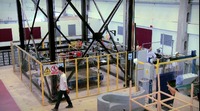 Principle Investigator Dr. Richard Buswell of Loughborough University in the UK leads a project to develop a method of 3D printing concrete building components that’s been ongoing for several years. The components could potentially accommodate pre-made services, such as piping or electrical. The project will also enable the production of building geometries not easily done using other techniques by extruding custom designed components for later assembly on building sites.
Principle Investigator Dr. Richard Buswell of Loughborough University in the UK leads a project to develop a method of 3D printing concrete building components that’s been ongoing for several years. The components could potentially accommodate pre-made services, such as piping or electrical. The project will also enable the production of building geometries not easily done using other techniques by extruding custom designed components for later assembly on building sites.  While we’ve seen some experiments in concrete printing before, this project seems to be doing very well. The project uses a rather gigantic inkjet-like 3D printer that’s specially designed to control a concrete extruder. We can imagine much experimentation on developing the precise concrete mix for optimum extrusion and performance. The printer is capable of printing components up to 2 x 2.5 x 5m in size. Yes, that’s metres! We suspect anything larger would be kinda difficult to move around anyway.
While we’ve seen some experiments in concrete printing before, this project seems to be doing very well. The project uses a rather gigantic inkjet-like 3D printer that’s specially designed to control a concrete extruder. We can imagine much experimentation on developing the precise concrete mix for optimum extrusion and performance. The printer is capable of printing components up to 2 x 2.5 x 5m in size. Yes, that’s metres! We suspect anything larger would be kinda difficult to move around anyway. 

… have a look at the partner site, foster + partners, they do anything else but cheap.
… have a look at the partner site, foster + partners, they do anything else but cheap.
This process will probably not be used for cheap housing, but instead be used to produce elaborate and unusual concreate shapes for installation on building projects. If you just want straight, square walls, the old-fashioned way is still the cheapest. (And fastest, too.)
This process will probably not be used for cheap housing, but instead be used to produce elaborate and unusual concreate shapes for installation on building projects. If you just want straight, square walls, the old-fashioned way is still the cheapest. (And fastest, too.)
Professor, please stop dinking around and get this into commercial production. The people of the world don't need fancy curves or embedded utilities. They do need simple, cheap housing.
Professor, please stop dinking around and get this into commercial production. The people of the world don't need fancy curves or embedded utilities. They do need simple, cheap housing.